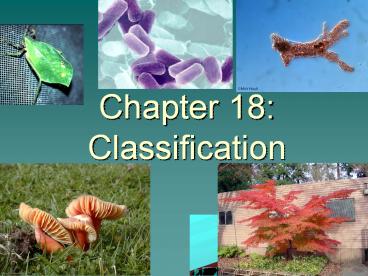Chapter 18: Classification - PowerPoint PPT Presentation
Title:
Chapter 18: Classification
Description:
Chapter 18: Classification * * 18 1 Finding Order in Diversity Life on Earth has been changing for more than 3.5 billion years 1.5 million species named between 2 ... – PowerPoint PPT presentation
Number of Views:291
Avg rating:3.0/5.0
Title: Chapter 18: Classification
1
Chapter 18 Classification
2
181 Finding Order in Diversity
- Life on Earth has been changing for more than 3.5
billion years - 1.5 million species named
- between 2 and 100 million additional species have
yet to be discovered
3
Why Classify?
- organize living things into groups that have
biological meaning - Taxonomy discipline of classifying organisms
and assigning each organism a universally
accepted name
4
Assigning Scientific Names
- Common names are confusing and vary among
languages or even regions - Ex cougar, mountain lion, panther, puma
- different species sometimes share a single common
name - Ex buzzard hawk? Vulture?
- Scientists have agreed to a single name for each
species - Use Latin Greek
5
Binomial Nomenclature
- Carolus Linnaeus,
- a Swedish botanist, 1700s
- binomial nomenclature classification system in
which each species is assigned a two-part
scientific name - written in italics
- first word is capitalized, the second word is
lower case
6
Scientific Names
- grizzly bear is called Ursus arctos
- Ursus is the genus
- Genus group of closely related species
- arctos is the species
- unique to each species within the genus
- Often a Latinized description of some important
trait of the organism or an indication of where
the organism lives - Ursus maritimus, the polar bear
- maritimus, referring to the sea
7
(No Transcript)
8
Linnaeus's System of Classification
- Hierarchical - it consists of levels
- includes seven levels
- from smallest to largestspecies, genus, family,
order, class, phylum, and kingdom. - Each level is called a taxon or taxonomic
category
9
(No Transcript)
10
Ursus arctos (Grizzly Bear)
- Kingdom Animalia
- Phylum Chordata
- Class Mammalia
- Order Carnivora
- Family Ursidae
- Genus Ursus
- species - arctos
11
Humans
- Kingdom Animalia
- Phylum (Division for plants) Chordata
- Class Mammalia
- Order Primates
- Family Hominidae
- Genus Homo
- species sapiens
12
- Taxonomic groups above the level of species are
invented by researchers who decide how to
distinguish between one genus, family, or phylum,
and another.
13
- Phylogeny the study of evolutionary
relationships among organisms - Biologists now group organisms into categories
that represent lines of evolutionary descent, or
phylogeny, not just physical similarities.
14
- evolutionary classification method of grouping
organisms together according to their
evolutionary history
15
- The higher the level of the taxon, the farther
back in time is the common ancestor of all the
organisms in the taxon.
16
- Cladogram diagram that shows the evolutionary
relationships among a group of organisms
17
(No Transcript)
18
(No Transcript)
19
(No Transcript)
20
- The genes of many organisms show important
similarities at the molecular level. - Similarities in DNA can be used to help determine
classification and evolutionary relationships. - The more similar the DNA sequences of two
species, the more recently they shared a common
ancestor, and the more closely they are related
in evolutionary terms.
21
Dichotomous Key
- A dichotomous key is a tool that allows the user
to determine the identity of items in the natural
world, such as trees, wildflowers, mammals,
reptiles, rocks, and fish. - Keys consist of a series of choices that lead the
user to the correct name of a given item. - "Dichotomous" means "divided into two parts".
Therefore, dichotomous keys always give two
choices in each step.
22
(No Transcript)
23
183 Kingdoms and Domains
- There are now 6 Kingdoms listed below.
24
- Domain most inclusive taxonomic category
larger than a kingdom
25
Eubacteria
- Unicellular
- Prokaryotic
- Autotroph or heterotroph
- Cell walls with peptidoglycan
- Examples E. coli, Streptococcus, Staph
26
Archaebacteria
- unicellular
- prokaryotic
- extreme environments
- volcanic hot springs, brine pools, and black
organic mud totally devoid of oxygen - Auto or heterotroph
- cell walls lack
- peptidoglycan
27
Protista
- eukaryotic
- greatest variety
- Most single-celled, some multi
- photosynthetic or heterotrophic
- Ex kelp, amoebas, slime mold, paramecium, euglena
28
(No Transcript)
29
Fungi
- heterotrophs
- feed on dead or decaying
- organic matter
- Eukaryotic
- Most multicellular, some uni
- Cell walls of chitin
- EX mushroom, yeast
30
Plantae
- multicellular
- photosynthetic autotrophs
- Eukaryotic
- Cells walls of cellulose
31
Animalia
- multicellular
- heterotrophic
- Eukaryotic
- No cell walls































